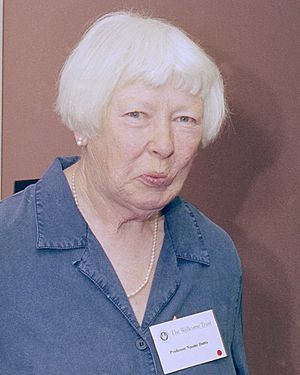Naomi Datta facts for kids
Quick facts for kids
Naomi Datta
|
|
|---|---|

Datta in May 1998
|
|
| Born | 17 September 1922 |
| Died | 30 November 2008 |
| Medical career | |
| Research | Bacteriology |
Naomi Datta (born Naomi Goddard; 17 September 1922 – 30 November 2008) was a very important British scientist. She was a geneticist, which means she studied genes and how living things inherit traits. Working at Hammersmith Hospital in London during the 1950s and early 1960s, she made a big discovery. She found out that bacteria could share their genes, which made them resistant to many different medicines (called antibiotics). This process is known as horizontal gene transfer.
Contents
Her Amazing Discoveries
After becoming a doctor in 1946, Naomi Datta joined a special lab that studied germs (bacteria) for public health. She worked there for ten years. Then, in 1957, she moved to Hammersmith Hospital. She started as a lecturer and later became a professor who taught about the genetics of tiny living things (microbes).
At Hammersmith Hospital, Naomi Datta made a huge discovery. She showed that bacteria could pass on their resistance to medicines to other bacteria. This was the first time anyone outside Japan had found this!
In 1959, there was a serious outbreak of a specific type of Salmonella germ. As part of her research, Datta looked at 309 samples of this germ. She wanted to see if the germ changed after moving through different people. She found that 25 of these samples were resistant to medicines. Eight of them were resistant to a medicine called Streptomycin, which had been used to treat the patients.
Naomi Datta noticed something important: the Salmonella samples from the beginning of the outbreak were not resistant to medicines. This meant that the bacteria had developed resistance over time.
Sharing Her Findings
Naomi Datta shared her discoveries in scientific papers. In 1960, she published "An outbreak of infection with Salmonella typhimurium in a general hospital." Later, in 1962, she published "Transmissible drug resistance in an epidemic strain of Salmonella typhimurium" in the Journal of Hygiene.
In the years that followed, she wrote many important studies. These studies were about how common and important these medicine-resistant genes (called plasmids) were in gut infections. She even helped create a way to name bacterial plasmids so all scientists would use the same words.
She also made great contributions to understanding how R factors work. R factors are special genes that cause bacteria to become resistant to medicines. She was a leader in sorting R factors and other plasmids into groups. She found that some resistance genes, like those for resistance to a medicine called gentamicin, can jump from one part of a cell to another. This means they can spread easily.
Her Early Life
Naomi Goddard was born in London, England, in 1922. She went to school in England and then studied in Paris, France. When World War II started, she came back to England. She then studied medicine at University College London (UCL).
She met her husband, Prakash Datta, in 1943. She had moved away from London for safety during the war. She became a doctor in 1946. The next year, she worked as a new doctor in different hospitals.
Later Years and Retirement
Naomi Datta retired in 1984. She became an honorary professor of microbial genetics at the University of London. The year after she retired, in 1985, she was chosen to be a Fellow of the Royal Society. This is a very high honor for scientists.
Even in retirement, she loved to learn. She took a course in linguistics, which is the study of language. Then, she earned a master's degree in human evolution. She was 75 years old at the time, making her the oldest person in her class!
Naomi Datta was also known for her cooking and being a great host. She even contributed to a cookbook published by the Royal Society called But the crackling is superb. She passed away on November 30, 2008.
Images for kids


